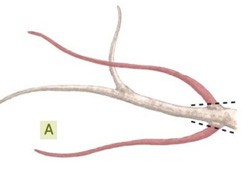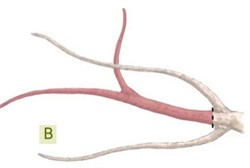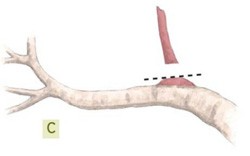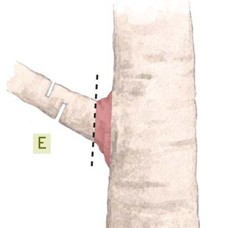When properly located in the garden and provided enough space to grow to their mature size, Japanese maples usually do not require much if any pruning. However, if your Japanese maple has grown beyond the boundaries of the area it was intended to fill some pruning may be necessary.





With a few good tips, most gardeners can safely do some light pruning on Japanese maples. However, when performing major pruning on a Japanese maple tree I would highly suggest leaving this job to the experts, such as a certified arborist.
The Basics...
When to Prune
Major pruning is best performed during the winter months, when the tree is totally dormant however some experts prune during the summer.
Consider Shape
Before pruning a Japanese maple, first identify the ideal form of the particular cultivar, so you know what you are aiming for. Is the cultivar intended to be upright? with a vase shape? Horizontally branched? Weeping? The goal of pruning is to encourage the tree's natural and healthy growth habit. If you don't know your particular tree's habit, do a Google image search to see what it's supposed to look like.
Pruners
Make sure you use a sharp and clean pair of pruners. Most hand pruners (bypass pruners) work well for branches and stems under 3/4 of an inch in diameter. Branches over 3/4 inch in diameter might require lopper pruners (long handled pruners).
Prune With Constraint
Keep in mind that when pruning a Japanese maple to prune with restraint. Look the tree over carefully, even getting under it and looking up, to identify what you want to prune. Before cutting a branch, see where it goes. If removing the branch will spoil the shape of the tree do not remove it. Step back between every cut you make to consider the effect it has had and to determine which branch or stem could be cut next to improve the shape. When in doubt about removing a branch leave it alone. You don't want to remove a branch or stem that would spoil the shape and look of the tree. Scroll below for detailed pruning tips and diagrams.
Where to Start
As with any tree or shrub, first cut out all dead wood, especially from the interior of mounded varieties, This helps for better air circulation and overall growth. Next, look for branches that are rubbing against each other. If one of these can be removed without spoiling the shape of the tree, keep the one that will contribute most to a pleasing shape and cut the other back to the next branch. When cutting a branch, make sure to make the cut just outside of the branch collar, as shown in one of the diagrams further below.
During the rest of the pruning process aim to create balance and accentuate the intended form of the tree. In other words, prune it to enhance its natural shape and form.
Here's some basic shaping tips:
- On a weeping, mounded Japanese maple any branches that are growing upwards can be removed.
- If it's an upright variety, remove any branches that are growing downward.
- If it’s a laceleaf that appears too dense, carefully select branches or stems that could be removed so that light can emphasize the leaf form.
- If the bark is a special feature, such as with the coral or golden bark maples, and the foliage is too dense, selectively prune to make sure some of the colorful branches are visible.
- If there are branches straying outside of the intended form, making the tree look lopsided, these can be cut back to a point just outside the main form of the tree.
Here's a few tips on how to make various types of pruning cuts...
Tip 1 - Pruning a Japanese Maple Tree
Prune away dead and overlapping branches, as shown in illustration A. Deadwood is relatively easy to spot; dead branches are leafless in the growing season, brittle and a dull gray color, unlike healthy branch color.

Tip 2 - Pruning a Japanese Maple Tree
Use what's known as a "selective heading cut" to remove main branches growing between two healthy buds or branches, as shown in illustration B. Cut as close as you can to the base without doing any damage to the buds or other branches.

.
Tip 3 - Pruning a Japanese Maple Tree
Prune side branches back to a healthy wood. Be sure to leave the branch collar, the swelling where a branch joins the trunk, as shown in illustration C. Cutting into the collar or leaving a longer stub will delay or prevent healing.

.
Tip 4 - Pruning a Japanese Maple Tree
Do not cut off tips of stems. this results in rapid, unhealthy, bunched up growth.

Tip 5 - Pruning a Japanese Maple Tree
For larger branches, use the technique shown in illustration E to prevent limbs from breaking during pruning. Make a cut partially through on the upper and underside of the branch before making the cut just outside the branch collar.

Other Tips
- Direct growth by controlling buds. Buds point in the direction they will grow, and one often becomes the dominant branch. You can direct the growth by rubbing a bud out with your fingernail, or you can wait to see how the branches develop.
- Avoid seal pruning cuts with a pruning sealer; this old practice has been shown to be unnecessary and sometimes counterproductive. Allow cuts to heal naturally.
- Avoid pruning that results in large differences in branch diameters. Pruning a large branch back to a small side branch gives an unbalanced appearance. Light pruning limits regrowth and protects bark from sun scorch.
- Periodically step back and examine your work from different angles. Look at your tree from the base up, following a branch upward to assess what and where to prune. Don't rush, and if in doubt, don't cut.
- Avoid heavy annual pruning to make a tree that's too big fit into a small garden. Instead, remove it, give it away and replace it with a more size-appropriate tree.
- Keep your pruners clean and sharp - sharpen at least twice a year if used a lot.
- Beginners beware, it's best to consult an arborist for large branches with included bark.
- Light pruning can be done any season except spring, when sap is rising.

